M47 Patton
| M47 Patton | |
|---|---|
|
M47 Patton on display | |
| Type | Medium tank[1] |
| Place of origin | United States |
| Service history | |
| In service | 1952–early 1960s (USA) |
| Wars | Suez Crisis, Indo-Pakistani War of 1965, Six Day War, 1971 Indo-Pakistani War, Turkish invasion of Cyprus, Ogaden War, Iran–Iraq War, Somali Civil War, Yugoslav Wars |
| Production history | |
| Manufacturer |
Detroit Arsenal Tank Plant American Locomotive Co. |
| Produced | 1951–1953 |
| Number built | >9,000 |
| Specifications | |
| Weight | 48.6 short tons (44.1 t) combat ready [2] |
| Length | 27 ft 11 in (8.51 m) |
| Width | 11 ft 6.25 in (3.51 m) |
| Height | 11 ft (3.35 m) |
| Crew | 5 (commander, gunner, loader, driver, assistant driver) |
|
| |
| Armor |
Upper Glacis: 4 in (100 mm) at 60° = 8 in (200 mm) LoS Turret Front: 4 in (100 mm) at 40° = 5.22 in (133 mm) LoS[3] |
Main armament |
90 mm gun M36 71 rounds |
Secondary armament |
1 × .50 cal (12.7 mm) M2 machine gun (roof-mounted)[2] 2 x .30 cal (7.62 mm) M1919A4 machine gun (one flexible mount at right front of hull, one coaxial with the 90mm cannon)[2] |
| Engine |
Continental AV-1790-5B V12, air-cooled, Twin-turbo gasoline engine 810 hp (600 kW) |
| Power/weight | 17.6 hp (13.6 kW) / tonne |
| Transmission | General Motors CD-850-4, 2 ranges forward, 1 reverse |
| Suspension | Torsion bar suspension |
| Fuel capacity | 233 US gal (880 l; 194 imp gal)[2] |
Operational range | 100 mi (160 km)(In average conditions)[2] |
| Speed | 37 mph (60 km/h)[2] |
The M47 Patton is the second American tank to be named after General George S. Patton, commander of the U.S. Third Army during World War II and one of the earliest American advocates of tanks in battle. It was a development of the M46 Patton tank mounting an updated turret,[4] and was in turn further developed as the M48 Patton.
History
The M47 was the U.S. Army's and Marine Corps' primary tank, intended to replace the M46 Patton and M4 Sherman medium tanks.[5] The M47 was widely used by U.S. Cold War allies, both SEATO and NATO countries, and was the only Patton series tank that never saw combat while in US service.
Although roughly similar to the later M48s and M60s, these were completely new tank designs. Many different M47 Patton models remain in service internationally. The M47 was the last US tank to have a bow-mounted machine gun in the hull.
Design
Although a new power plant corrected the mobility and reliability problems of the M26 Pershing, the subsequently renamed M46 was considered a stopgap solution that would be replaced later by the T42 medium tank. However, after fighting erupted in Korea, the Army decided that it needed the new tank earlier than planned. It was deemed that there was not enough time to finish the development of the T42 and fix various problems that were likely to emerge in the new design. The final decision was to produce another interim solution, with the turret of the T42 mounted on the familiar hull of the M46. The composite tank, developed by the Detroit Arsenal, was named the M47 Patton and entered production in 1951. Its main gun was the M36 90 mm gun with an M12 optical rangefinder fitted. The secondary armament consisted of two .30cal Browning machine guns, one in the bow of the hull and one coaxial machine gun in the turret, and a .50cal Browning M2 on a pintle mount on the turret roof. The M47 was the last American-designed tank to include a bow machine gun. The T42 turret had a larger turret ring than the M26/M46 turret, and featured a needle-nose design, which improved armor protection of the turret front (similar to the M60A1 tank of 1962), an elongated turret bustle and storage bin which protruded halfway across the engine deck, and the turret sides were sloped to further improve ballistic protection; this gave the turret a decidedly lozenge-shaped profile. It also featured the M12 stereoscopic rangefinder, which was designed to improve first-round hit probability but proved difficult to use; the rangefinder protruded from both sides of the upper turret front, which would be a feature of American tanks until the advent of the M1 Abrams in 1980.[6]
Production began at the Detroit Tank Arsenal in June 1951 before the M47 was standardized for production. Delays in the shipment of the M12 rangefinder and other problems due to the rushed production schedule caused a protracted testing period, and the first M47s were not fielded to the 1st and 2nd Armored Divisions until summer 1952. Standardized in May 1952, the M47 Patton's production ran until November 1953; Detroit built 5,481 tanks, and American Locomotive Company (Alco) produced 3,095, for a total production run of more than 9,000 M47 Pattons.[7]
Deployment
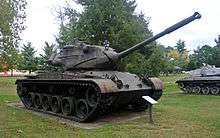
With the arrival of the improved M48 Patton in 1953, the M47 was declared 'limited standard' in 1955, and examples in tank units were replaced with the M48 series soon after.[8] After being declared obsolete in 1957, M46s and M47s were retained in active duty infantry division battlegroup assault gun platoons (four tanks each, one platoon per battlegroup, for a total of 20 tanks per division) until replaced with the light truck-mounted SS-10 anti-tank guided missile in the early 1960s.[9] M47s were used by the Reserves for a relatively short time, soon being replaced by early production M48 Patton series tanks; thus, most of the M47s were exported in the late 1950s.[8][10]
The US Marine Corps also fielded M47s starting in late 1952; after the Korean War, all seven Marine tank battalions, three divisional, two reserve training, and two force level, each fielded M47s. But these were soon replaced with M48A1 Pattons and M103 heavy tanks, with the last M47s being retired in 1959.[11]
The M47 was widely used by many countries, especially NATO and SEATO allies, including Austria (147), Belgium (784), Ethiopia (30), France (856), Greece (396[12] from USA and West Germany), Iran (around 400), Italy (2,480), Japan (1 for evaluation only), Jordan (49), Pakistan (100), Portugal (161), Saudi Arabia (23 from the US, 108 on the international market), Somalia (25 from Saudi Arabia), South Korea (531), Sudan (17 from Saudi Arabia), Spain (389), Switzerland (2 for evaluation), Turkey (1,347 from the US and West Germany), West Germany (1,120), and Yugoslavia (319).[13] Like the US Army of the time, the West German Bundeswehr also used some of their M47s as interim tank destroyers/assault guns until replaced by the Raketenjagdpanzer 1 tank destroyers armed with SS-11 anti-tank guided missiles in the early 1960s.[14]
US Army M47s remaining in storage were expended as targets; in the 1970s, they were used for the M60A1's 105mm gun with devastating effect. The 105 mm HEAT round would penetrate the frontal armor with ease. Many M47s in like-new condition met their fate in this manner, showing the M60 crews first hand the effects of modern tank weapons on conventional steel armor.
Combat service

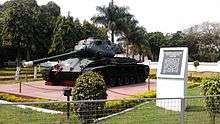
- Pakistan used M47s against India in the Indo-Pakistani War of 1965 and Indo-Pakistani War of 1971.
- Jordan used M47s against Israel in the Six Day War in 1967.
- The M47 was used by the Turkish Army, in the Turkish invasion of Cyprus in July and August 1974, with an estimated 200 Pattons involved in the action. At least one operational M47, number 092273, was captured by the Cyprus National Guard and remained in service until 1993. The example is currently stored at the camp of the 25 EMA in Paphos as a training and memorial exhibit.[15]
- Iran used M47s against Iraq in the Iran–Iraq war. Iranian M47s performed poorly against Iraqi tanks such as T-62s and T-72s. Large numbers of M47 tanks were captured by the Iraqis.[16]
- In the 1980s and early 1990s, the Turkish army used M47 tanks against PKK guerrillas in Turkey and Iraq. Turkish M48A5 variants replaced all remaining M47s in the late 1990s.
- Croatia used M47s against the Serbs in the Croatian War of Independence but their performance was inferior to that of the Soviet-designed T-55s. The M47s were retired from service immediately after the war, and are now used as gunnery/missile targets during military exercises.
- In the Somalian Civil War, some of the country's large pre-war M47 collection may have seen service in the initial stages, but these aging vehicles soon ceased operations due to a lack of spares and maintenance.
- France deployed a squadron of M47s against Egypt during the Suez crisis in 1956.
Variants
- M46E1 – pilot model, M46 hull with T42 turret, fitted with the M36 90 mm Gun, and was longer to incorporate a radio, ventilator, and featured a stereoscopic rangefinder; only one built[17]
- M47 – main production version, M46 hull modified with redesigned glacis, reduction from five to three track return rollers per side, longer mufflers on rear fenders; 8,576 built[18]
- M47M – The product of an improvement program started in the late 1960s, the M47M featured the engine and fire control elements from the M60A1. The assistant driver's position was eliminated in favor of additional 90 mm ammunition. Not used by the US; over 800 vehicles were produced for Iran and Pakistan[19]
- M47E – Spanish M47M austere version (kept original FCS).
- M47E1 – Second Spanish upgrade batch with rearranged main gun ammunition storage and crew heater. Both new and upgraded M47Es. 330 converted.
- M47E2 – 45 built. M47E1 with Rh-105 105 mm gun and improved FCS (still electromechanical). Passive night vision for driver and commander. All M47 series MBT in Spanish service retired 1993.
- M47ER3 – Spanish armored recovery vehicle. 22 built.
- Sabalan – An Iranian upgraded version of the US M47M, It has side skirts and a newly built turret fitted with a 105-mm gun, laser range finder, new fire control system and communication equipment.[20][21]
Additional equipment
- M6 – Earth Moving Tank Mounting Bulldozer. Bulldozer kit for the M47 series.
- Unknown name - Switching 90mm M36 to 90mm M41 which used by M48 Patton III.
Operators
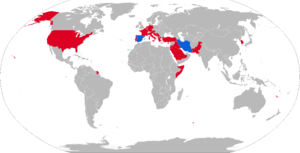
Current operators
-
 Spain – 22 M47ER3 ARV based on M47 hulls modernized in 1992–94. Currently used as recovery vehicles in artillery and infantry units.
Spain – 22 M47ER3 ARV based on M47 hulls modernized in 1992–94. Currently used as recovery vehicles in artillery and infantry units. -
 Iran
Iran
Former operators
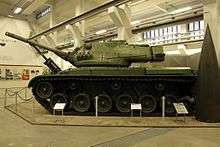
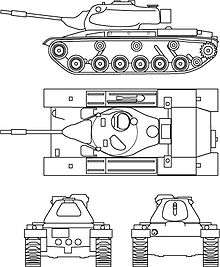
-
 Austria - 153 M47s in active service from 1957 till 1982. Since 1972, turrets of retired M47 tanks were fixed in Austrian bunker systems.
Austria - 153 M47s in active service from 1957 till 1982. Since 1972, turrets of retired M47 tanks were fixed in Austrian bunker systems. -
.svg.png) Belgium – One of the surviving examples is visible in the Brussels Military Museum
Belgium – One of the surviving examples is visible in the Brussels Military Museum -
 Bosnia and Herzegovina[22]
Bosnia and Herzegovina[22] -
 Croatia – Over 20 during the Croatian War of Independence, 16 units remained in service by 1996 but were soon retired.
Croatia – Over 20 during the Croatian War of Independence, 16 units remained in service by 1996 but were soon retired. -
 Cyprus – One captured vehicle.
Cyprus – One captured vehicle. -
 France – 856 (1954–1970)
France – 856 (1954–1970) -
 Greece – 396 pieces in total, of which 391 were scrapped between 1992 and 1995.
Greece – 396 pieces in total, of which 391 were scrapped between 1992 and 1995. -
 Iraq – Captured from Iran. All destroyed or scrapped.
Iraq – Captured from Iran. All destroyed or scrapped. -
 Italy
Italy -
 Jordan[23]
Jordan[23] -
 Republic of Korea – Acquired a total of 531 vehicles—463 for the army between 1956 and 1959, and 68 for the marine corps between 1963 and 1964—mainly from the USFK. Around three-quarters of the M47s replaced their 90mm M36 guns with the 90mm M41 guns that became available when their M48s upgraded their guns from 90mm M41 to 105mm M68. The last vehicle was out of service in 2007.
Republic of Korea – Acquired a total of 531 vehicles—463 for the army between 1956 and 1959, and 68 for the marine corps between 1963 and 1964—mainly from the USFK. Around three-quarters of the M47s replaced their 90mm M36 guns with the 90mm M41 guns that became available when their M48s upgraded their guns from 90mm M41 to 105mm M68. The last vehicle was out of service in 2007. -
 Netherlands[24]
Netherlands[24] -
 Pakistan – Retired in 2002–2003 [25]
Pakistan – Retired in 2002–2003 [25] -
 Portugal
Portugal -
 Saudi Arabia
Saudi Arabia -
 Somalia
Somalia -
 West Germany - 1,102 tanks were fielded.[26]
West Germany - 1,102 tanks were fielded.[26] -
 Turkey – 1,347 tanks were fielded. Today all M47s were recycled and the steel used for civil purposes, except one tank that was delivered to the Istanbul Military Museum and one tank as war memorial in location 35°19′39″N 33°8′28″E / 35.32750°N 33.14111°E (Cyprus).
Turkey – 1,347 tanks were fielded. Today all M47s were recycled and the steel used for civil purposes, except one tank that was delivered to the Istanbul Military Museum and one tank as war memorial in location 35°19′39″N 33°8′28″E / 35.32750°N 33.14111°E (Cyprus). -
 United States
United States -
 Yugoslavia – Total of 319 delivered during the 1950s when U.S. President Dwight D. Eisenhower feared that the USSR could attack Yugoslavia via the Hungarian-Yugoslav border.
Yugoslavia – Total of 319 delivered during the 1950s when U.S. President Dwight D. Eisenhower feared that the USSR could attack Yugoslavia via the Hungarian-Yugoslav border.
Evaluation only operators
-
 Japan – Evaluation only.
Japan – Evaluation only.
Civilian operators
-
 United States – 1 former Austrian Army M47 owned by Arnold Schwarzenegger. He previously operated the vehicle during his mandatory service in 1965 and now uses it to support his charity.[27]
United States – 1 former Austrian Army M47 owned by Arnold Schwarzenegger. He previously operated the vehicle during his mandatory service in 1965 and now uses it to support his charity.[27]
See also
- T-54 -Soviet tank
- M26 Pershing
- M46 Patton
- M48 Patton
- Type 61
- M60 Patton
- List of armoured fighting vehicles
- M103 heavy tank
- G-numbers SNL G262
References
- ↑ Hunnicutt, p. 35
- 1 2 3 4 5 6 Department of the Army and the Air Force. Military Vehicles (Ordnance Corps Responsibility). Department of the Army Technical Manual, 1953, February 1953 p. 119.
- ↑ Hunnicutt, R.P. (1984). Patton: A History of the American MBT. Presidio. p. 425.
- ↑ Hunnicutt
- ↑ although the Ordnance Committee Minutes/OCM #33476 ceased utilizing the heavy, medium, and light tank designations on 7 November 1950; going to the "...Gun Tank designation")
- ↑ Jim Mesko "Pershing/Patton in action" ISBN 0-89747-442-2 pp. 41-45.
- ↑ Mesko, p. 41.
- 1 2 Mesko, p. 47.
- ↑ Department of the Army, "Field Manual FM 7-21 Headquarters and Headquarters Company Infantry Division Battle Group", 8 August 1957, pp. 185, 205.
- ↑ Steven J. Zaloga "The M47 and M48 Patton Tanks" ISBN 1-85532-825-9 pp. 6, 12-38, 44-45.
- ↑ George F. Hofmann and Donn A. Starry "Camp Colt to Desert Storm: The History of U.S. Armored Forces" ISBN 0-8131-2130-2 p. 281.
- ↑ Σχολή Αξιωματικών Τεθωρακισμένων, Γραφείο Μελετών, Ιστορία Ιππικού-Τεθωρακισμένων, Αυλώνας 1995, pages A9-A13. Also page 58: beginning in 1992 the Greek army scrapped 391 M47 as part of the CFE agreement
- ↑ Zaloga, ibid.
- ↑ Peter Blume, "Die Anfangsjahre des Heeres 1956-1966", Tankograd Publishing 2003, pp. 46-47.
- ↑ The Action of the Captured M47 in Attila II in The Unknown Soldier of Cyprus (Savvas Vlassis) 1997
- ↑ "Американский танк 50-х годов получил шанс на новую жизнь". warfiles.ru. Retrieved 13 February 2015.
- ↑ Mesko, pp. 41, 43
- ↑ Mesko, p. 41
- ↑ Mesko, pp. 41, 43, 45
- ↑ http://www.military-today.com/tanks/sabalan.htm
- ↑ "بازگشت مقتدرانه قدیمیترین تانک ایرانی پس از 60 سال +عکس". Retrieved 13 February 2015.
- ↑ Ivan Bajlo. "M-47 Patton". Retrieved 13 February 2015.
- ↑ "M47 Patton II". Military Factory. Retrieved 7 May 2015.
- ↑ "M47 Patton II". Military Factory. Retrieved 7 May 2015.
- ↑ John Pike. "Pakistan Army Equipment". Retrieved 13 February 2015.
- ↑ "M47 (Patton II) Medium Tank (1951)". Militaryfactory.com. Retrieved 1 January 2016.
- ↑ Matt McDaniel. "Arnold Schwarzenegger takes his own personal tank out for a spin". Retrieved 3 March 2015.
Bibliography
- Hunnicutt, R. P. "Patton: A History of the American Main Battle Tank." (Vol 1), 1984, Presidio Press; ISBN 0-89141-230-1.
External links
| Wikimedia Commons has media related to M47 tanks. |
- AFV Database: M47 Patton
- GlobalSecurity.org: M47 Patton
- Patton-Mania
- M47 Photos and Walk Arounds on Prime Portal
- "Army's Latest Medium Tank Features Lethal Firepower." Popular Mechanics, June 1952, p. 88. early public relation article for M-47.
